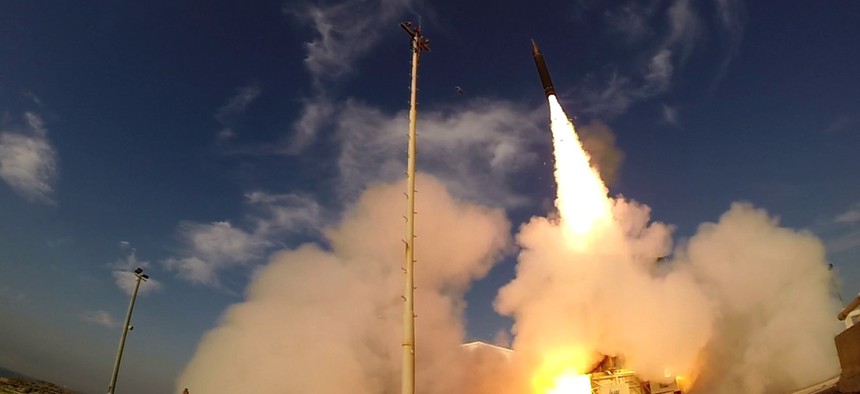
he Israel Missile Defense Organization (IMDO) of the Directorate of Defense Research and Development (DDR&D) and the U.S. Missile Defense Agency (MDA) conducted a successful first engagement of a ballistic missile target with the Arrow-3 interceptor on De Leah Garton / MDA
Drones Will Help Protect Guam From North Korean Missiles
A June 2016 test showed that drones can track missiles, promising better protection for forces and allies under threat of a North Korean missile strike.
POWAY, California — Teams of modified MQ-9 Reaper drones are being prepped to keep airborne eyes on North Korea, ready to track missile launches and feed crucial data to Navy interceptor warships far offshore, the drones’ maker says.
A June 2016 missile defense drill called Pacific Dragon, which brought together the militaries of Japan, the U.S., and South Korea, showed that a pair of modified MQ-9 Reaper drones could effectively track a ballistic missile. The successful tracking was due in part to special Multi-Spectral Targeting System C sensors from Raytheon aboard the drones. Their electro-optical infrared sensors can detect the heat of a missile as it enters its boost phase. A pair of these modified drones can triangulate on the plume to obtain 3D targeting data, helping interceptor ships draw a better bead on the flying missiles.
Now General Atomics Aeronautical Systems, which makes the Reaper, is working to improve its ability to contribute to missile defense.
“Let’s just say that within the next few years, there’s lots of improvements in the tracking capability. The accuracy in the early part of the boost phase that this provides is game-changing,” company president David Alexander told reporters last week at the company’s headquarters here. “If I say any more, I might get into trouble.”
The U.S. Missile Defense Agency is looking to do more testing in coming years, according to a separate source familiar with the matter. MDA wants to reduce to one the number of Reapers needed to track enemy launches, likely by adding a tracking laser to keep tabs on the soaring missile, the source said.
Further into the future, Alexander said that the company’s large, jet-powered Predator C “Avenger” drone could add a layer of surveillance and targeting data to North Korea — or anywhere else the military might want one. Originally designed for the U.S. Navy’s aborted Unmanned Carrier-Launched Airborne Surveillance and Strike, or UCLASS program, the Avenger and its 3,000-pound-capacity weapons bay could loft the massive, much longer-ranged l MS-177A sensor package (the MS stands for multi-spectral) from United Technologies.
“That would be a sensor so big you couldn’t really put it on an MQ-9,” Alexander said.
Competitor Northrop Grumman is using the MS-177 in its $222.7 million Global Hawk drone for the Air Force.
Alexander said a Predator C, equipped for an MS-177 and priced at between $12 million to $15 million, might be able to do a similar job. And in the future, a similar long-range sensor with “very large aperture, so if you wanted to fly this airplane along the border of someone else’s country and look deep in,” said Alexander.





